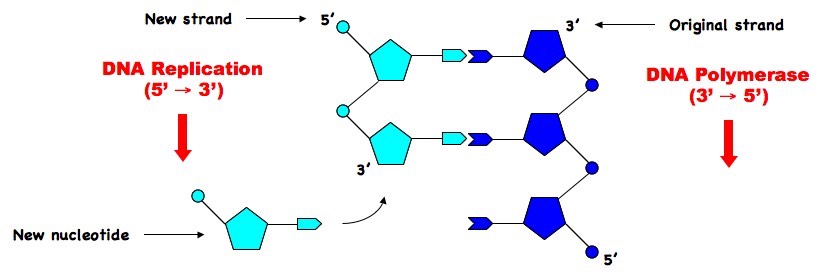7.2.1 State that DNA replication occurs in a 5' - 3' direction
- DNA replication is semi-conservative, meaning that a new strand is synthesised from an original template strand
- DNA replication occurs in a 5' - 3' direction, in that new nucleotides are added to the C3 hydroxyl group such that the strand grows from the 3' end
- This means that the DNA polymerase enzyme responsible for adding new nucleotides moves along the original template strand in a 3' - 5' direction
Direction of DNA Replication

7.2.2 Explain the process of DNA replication in prokaryotes, including the role of enzymes (helicase, DNA polymerase, RNA primase and DNA ligase), Okazaki fragments and deoxynucleoside triphosphates
- DNA replication is semi-conservative and occurs during the S phase of interphase
- Helicase unwinds and separates the double stranded DNA by breaking the hydrogen bonds between base pairs
- This occurs at specific regions (replication origins), creating a replication fork of two polynucleotide strands in antiparallel directions
- RNA primase synthesises a short RNA primer on each template strand to provide an attachment and initiation point for DNA polymerase III
- DNA polymerase III adds deoxynucleoside triphosphates (dNTPs) to the 3' end of the polynucleotide chain, synthesising in a 5' - 3' direction
- The dNTPs pair up opposite their complementary base partner (adenine pairs with thymine ; guanine pairs with cytosine)
- As the dNTPs join with the DNA chain, two phosphates are broken off, releasing the energy needed to form a phosphodiester bond
- Synthesis is continuous on the strand moving towards the replication fork (leading strand)
- Synthesis is discontinuous on the strand moving away from the replication fork (lagging strand) leading to the formation of Okazaki fragments
- DNA polymerase I removes the RNA primers and replaces them with DNA
- DNA ligase joins the Okazaki fragments together to create a continuous strand
Overview of DNA Replication

7.2.3 State that DNA replication is initiated at many points in eukaryotic chromosomes
- Because eukaryotic genomes are (typically) much larger than prokaryotic genomes, DNA replication is initiated at many points simultaneously in order to limit the time required for DNA replication to occur
- The specific sites at which DNA unwinding and initiation of replication occurs are called origins of replication and form replication bubbles
- As replication bubbles expand in both directions, they eventually fuse together, two generate two separate semi-conservative double strands of DNA
Origins of Replication![]()